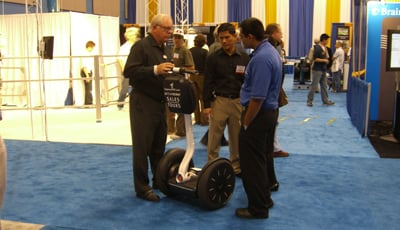
What? Segway is here? Aren't we stretching the definition of "robot" a little thin? Let's keep walking.
From CoroWare, there's the CoroBot (for which The Register gives permission to be confused with Coro, the Latin freestyle singer). The CoroBot is another example of a robot that's meant to be taken apart to suit the whims of the buyer.
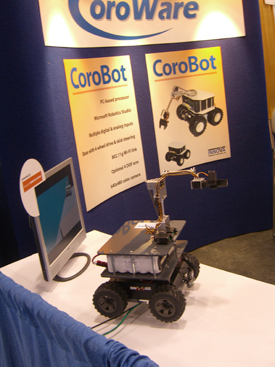
The bot is essentially a programmable mobile platform (as in a raised horizontal surface, not a software platform) with an optional crane claw. Another robot aimed at robotic researchers.
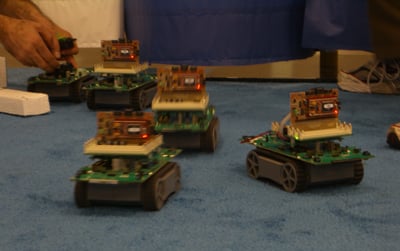
On the demo floor, there were little robots with "very simple programming" to avoid obstacles and hitting each other. Of course this meant they spent the majority of their time slamming into one another at full speed. Robots have excellent sense of comic timing when it comes to malfunctions.
As the show drew to a close, I got the terrible sensation that something was watching me.
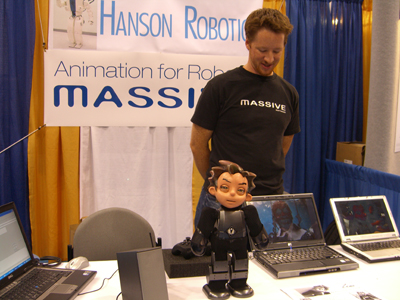
Now, just because something is a fraction of my size doesn't mean I'll just let it give me the stink-eye. In fact when it comes to confrontation I try to make certain they're a fraction of my size.
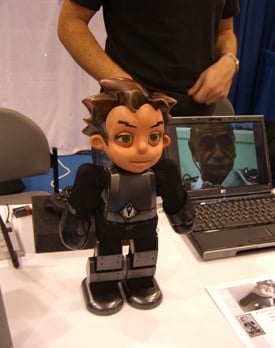
This 17" robot prototype is Zeno, a machine built by Hanson Robotics using technology from Massive Software. Massive is a developer of AI simulation software used in films such as the Lord of the Rings trilogy and Ratatouille</cite.
Zeno does the robo-navigation and responding to its physical environment thing — but can also make some impressive facial expressions with his rubbery little head.
Massive and Hansen can do some scary stuff. To the right of Zeno, you'll notice the face of Albert Einstein. That's not CG. That's a robot.
Let me show you why you should be terrified. Korean firm Kaist teamed with the two companies to make a robot that...
You'll just have to see the video. (YouTube warning.)
There's a popular hypothesis in robotics called "the uncanny valley," which was introduced by Japanese roboticist Mashahiro Mori in 1970. The hypothesis states that as robots (or other non-human entities) become more human-like in motion and appearance, they register as more appealing or empathetic to people.
For instance, a robot with a simple face is more visually appealing than a robo-crane on wheels. But only to a point. The uncanny valley is a theoretical drop-off point where the human facade reaches an extremely high level of realism — but still lacks all the subtle mannerisms, motion and details inherent of a true human being. The not-quite-human robot's flaws are then mentally highlighted, making it seem "off" and "creepy," like an animated corpse or body-snatcher.
The hypothesis continues that after a certain point, the empathy curve sweeps back up as the illusion of humanity is more successfully accomplished. Now while Einstein's head may well be leaving the valley, it still does so on the leathery wings of nightmares.
And now his grinning, yet oh-so sinister visage will visit you too whenever you close your eyes. Enjoy! ®
